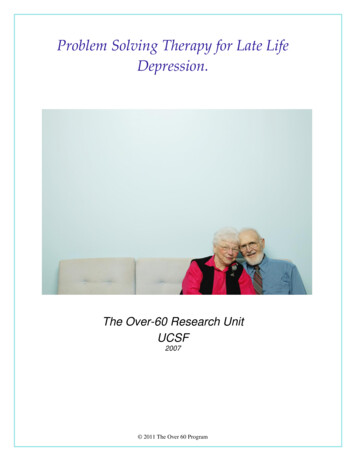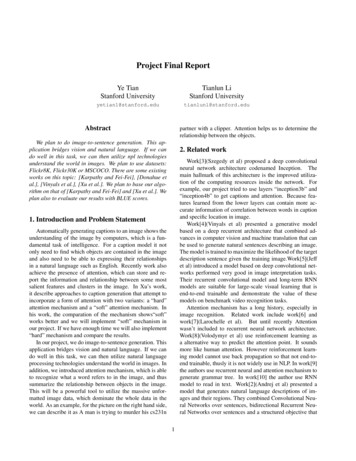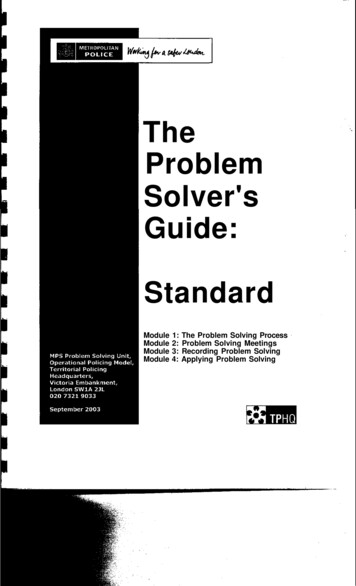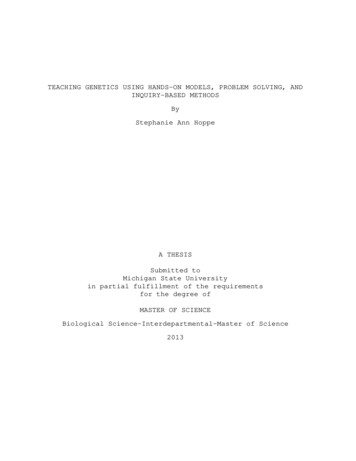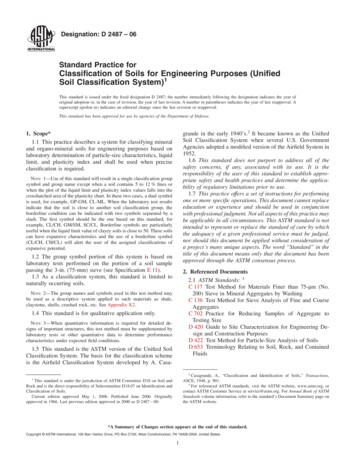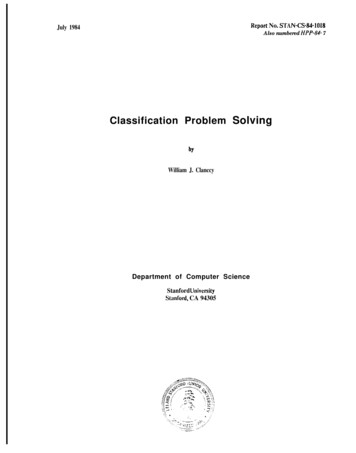
Transcription
Report No. STAN-CS-84-1018July 1984Also numbered HPP-84 7Classification Problem SolvingbYWilliam J. ClanccyDepartment of Computer ScienceStanford UniversityCA 94305SlilIlfOrd,
C’LASSIFICATIOS PROBLEM SOLVX%GWilliam .l. ClanceyDepartment of Computer ScienceStanford University. Stanford CA 94305Contract ho. SOOOl4-XI-tI302. ctffective Varch 15. 1979Exptration Dare: March 14. t985Total Amount of Contract -- 51.126.897Pnncipal Investigator. Bruce G Buchanan (1: 5) 497-0935Associate lnvestlgator. W:lham J Glance) (415) 197- 1997Sponsored jomtly by:Office of Naval Research and ;Zrm! Research lnstnutePersonnel and Trainmg Research Programs.Psychological Sciences Divtsion.’Contract Authont No. NR 154-481Screntitic Officer: Dr. Marshall Fat-rfhe \ iews and conclusions contamed In !hls document are those of the author, and chou!d nor be xrterpreted as nscessanl representing the official pohcies, either eupress or rmpited or che O:‘frcc of \a! ‘ii &search or ti!tt 1; S GotcrnmenrApproved for pubhc release; dr iributron unlimxed Rqrt d cuon in :vhole or in pan 1 permitteC for an) purpose of the CnitedStates Government.
AbstractA broad range of heuristic programs-embracing forms of diagnosis, catalog selection, andskeletal planning-accomplish a kind of well-structured problem solving called classification. Theseprograms have a characteristic inference structure that systematically relates data to a preenumerated set of solutions by abstraction, heuristic association, and refinement. This level ofdescription specifies the knowledge needed to solve a problem, independent of its representation in aparticular computer language. The classification problem-solving model provides a useful frameworkfor recognizing and representing similar problems, for designing representation tools, and forunderstanding the problem-solving methods used by non-classification programs.1. IntroductionOver the past decade a variety of heuristic programs have been written to solve problems in diverseareas of science, engineering, business, and medicine. Yet, presented with a given “knowledgeengineering tool, ” such as EMYCIN [39], we are still hard-pressed to say what kinds of problems itcan be used to solve well.Various studies have demonstrated advantages of using onerepresentation language instead of another-for ease in specifying knowledge relationships, controlof reasoning, and perspicuity for maintenance and explanation [9, 38, 1,2, lo]. Other studies havecharacterized in low-level terms why a given problem might be inappropriate for a given language, forexample, because data are time-varying or subproblems interact [21]. But attempts to describe kindsof problems in terms of shared features have not been entirely satisfactory: Applications-orienteddescriptions like “diagnosis” are too general (e.g., the program might not use a device model), andtechnological terms like “rule-based” don’t describe what problem is being solved [18, 191. Logic hasbeen suggested as a tool for a “knowledge level” analysis that would specify what a heuristicprogram does, independent of its implementation in a programming language [30, 291. However, wehave lacked a set of terms and relations for doing this.In an attempt to specify in some canonical terms what many heuristic programs known as “expertsystems” do, an analysis was made of ten rule-based systems (including MYCIN, SACON, and TheDrilling Advisor), a frame-based system (GRUNDY) and a program coded directly in LISP (SOPHIE Ill).There is a striking pattern: These programs proceed through easily identifiable phases of dataabstraction, heuristic mapping onto a hierarchy of pre-enumerated solutions, and refinement withinthis hierarchy. In short, these programs do what is commonly called classification.Focusing on content rather than representational technology, this paper proposes a set of termsand relations for describing the knowledge used to solve a problem by classification. Subsequent
2sections describe and illustrate the classification model in the analysis of MYCIN, SACON, GRUNDY,and SOPHIE III. Significantly, a knowledge level description of these programs corresponds very wellto psychological models of expert problem solving.This suggests that the classification problemsolving model captures general principles of how experiential knowledge is organized and used, andthus generalizes some cognitive science results.There are several strong implications for thepractice of building expert systems and continued research in this field.2. Classification problem solving definedWe develop the idea of classification problem solving by starting with the common sense notionand relating it to the reasoning that occurs In heuristic programs.2.1. Simple classificationASthe name suggests, the simplest kind of classification problem is to identify some unknownobject or phenomenon as a member of a known class of objects or phenomena. Typically, theseclasses are stereotypes that are hierarchically organized, and the process of identification is one ofmatching observations of an unknown entity against features of known classes. A paradigmaticexample is identification of a plant or animal, using a guidebook of features, such as coloration,structure, and size.Some terminology we will find helpful: The problem is the object or phenomenon to be identified;data are observations describing this problem; possible solutions are patterns (variously calledschema, frames or units); each solution has a set of features (slots or facets) that in some sensedescribe the concept either categorically or probabilistically; solutions are grouped into aspecialization hierarchy based on their features (in general, not a single hierarchy. but multiple,directed acyclic graphs); a hypothesis is a solution that is under consideration: evtdence is data thatpartially matches some hypothesis; the output is some solution.The essential characteristic of a classification problem is that the problem solver selects from a setof pre-enumerated solutions. This does not mean, of course, that the “right answer” is necessarilyone of these solutions, just that the problem solver will only attempt to match the data against theknown solutions, rather than construct a new one. Evidence can be uncertain and matches partial, sothe output might be a ranked list of hypotheses.Besides matching, there are several rules of inference for making assertions about solutions. Forexample, evidence for a class is indirect evidence that one of its subtypes is present. Conversely,
given a closed world assumption, evidence against all of the subtypes is evidence against a class.Search operators for finding a solution also capitalize on the hierarchical structure of the solutionspace. These operators include: refining a hypothesis to a more specific classification; categorizingthe problem by considering superclasses of partially matched hypotheses; and discriminating amonghypotheses by contrasting their superclasses [31.32, 121. For simplicity, we will refer to the entireprocess of applying these rules of inference and operators as refinement. The specification of thisprocess-a control strategy-is an orthogonal issue which we will consider later.2.2. Data abstractionIn the simplest problems, data are solution features. so the matching and refining process is direct.For example, an unknown organism in MYCIN can be classified directly given the supplied data ofgram stain and morphology.For many problems, solution features are not supplied as data, but are inferred by data abstraction.There are three basic relations for abstracting data in heuristic programs:lqualitative abstraction of quantitative data (“if the patient is an adult and white bloodcount is less than 2500, then the white blood count is low“);ldefinitional abstraction (“if the structure is one-dimensional of network construction,then its shape is a beam”); andlgeneralization in a subtype hierarchy (“if the client is a judge, then he is an educatedperson ‘I).These interpretations are usually made by the program with certainty; thresholds and qualifyingcontexts are chosen so the conclusion is categorical.It is common to refer to this knowledge as“descriptive, ” “factual,” or “definitional.”2.3. Heuristic classificationIn simple classification, the data may directly match the solution features or may match after beingPabstracted. In heuristic classification, solution features may also be matched heuristically. Forexample, MYCIN does more than identify an unknown organism in terms of features of a laboratoryculture:It heuristically relates an abstract characterization of the patient to a classification ofdiseases. We show this inference structure schematically, followed by an example (Figure Z-1).Basic observations about the patient are abstracted to patient categories, which are heuristicallylinked to diseases and disease categories. While only a subtype link with E.coli infection is shown
4HEURISTIC MATCHPatient Abstractions aDisease ClassesREFINEMENTDATAABSTRACTIONI0 iseasestPatient DataHEURISTICCompromised Host GENERALIZATIONGram-Negative InfectionSUBTYPEtlmmunosuppressedIE.coli InfectionGENERALIZATIONtLeukopeniaDEFINITIONALtLow WBCQUALITATIVEtWBC 2500Figure 2- 1: Inference structure of MYCIN
5here, evidence may actually derive from a combination of inferences. Some data might directly matchE.coli by identification. Discrimination with competing subtypes of gram-negative infection might alsoprovide evidence.As stated earlier, the order in which these inferences are made is a matter ofcontrol strategy.The important link we have added is a heuristic association between a characterization of thepatient (“compromised host”) and categories of diseases (“gram-negative infection”). Unlike thefactual and hierarchical evidence propagation we have considered to this point, this inference makesa great leap. A heuristic relation is based on some implicit, possibly incomplete. model of the world.This relation is often empirical, based just on experience; it corresponds most closely to the “rules ofthumb” often associated with heuristic programs [14].Heuristics of this type reduce search by skipping over intermediate relations (this is why we don’tcall abstraction relations “heuristics”).These associations are usually uncertain because theintermediate relations may not hold in the specific case.Intermediate relations may be omittedbecause they are unobservable or poorly understood. In a medical diagnosis program, heuristicstypically skip over the causal relations between symptoms and diseases.To repeat, classification problem solving involves heuristic association of an abstracted problemstatement onto features that characterize a solution.This can be shown schematically in simpleterms (Figure 2-2).This diagram summarizes how a distinguished set of terms (data, data abstractions, solutionabstractions, and solutions) are related systematically by different kinds of relations and rules ofinference. This is the structure of inference tn classification problem solving.In a study of physics problem solving, Chi [8] calls data abstractions “transformed” or “secondorder problem feafures.” In an important and apparently common variant of the simple model, dataabstractions are themselves patterns that are heuristically matched. In essence, there is a sequenceof classification problems. GRUNDY, analyzed below, illustrates this.2.4. Search in classification problem solvingThe issue of search is orthogonal to the kinds of inference we have been considering. “Search”refers to how a network made up of abstraction, heuristic, and refinement relations is interpreted, howthe flow of inference actually might proceed in solving a problem. Following Hayes [18], we call thisthe process structure. There are three basic process structures in classification problem solving:
6HEURISTIC MATCHData AbstractionsDATAABSTRACTION4a Solution AbstractionsREFINEMENTtSolutionsFigure 2-2: Classification problem solving inference structure1. Data-directed search: The program works forwards from data to abstractions, matchingsolutions until all possible (or non-redundant) inferences have been made.2. Solution- or Hypothesis-directed search: The program works backwards from solutions,collecting evidence to support them. working backwards through the heuristic relationsto the data abstractions and required data to solve the problem. If solutions arehierarchically organized, then categories are considered before direct features of morespecific solutions.3. Opportunistic search: The program combines data and hypothesis-directed reasoning1201. Data abstraction rules tend to be applied immediately as data become available.Heuristic rules “trigger” hypotheses, followed by a focused, hypothesis-directed search.New data may cause refocusing. By reasoning about solution classes, search need notbe exhaustive.Data- and hypothesis-directed search are not to be confused with the implementation terms“forward” or “backward chaining.” Rl provides a superb example of how different implementationand knowledge level descriptions can be. Its rules are interpreted by forward-chaining, but it does a
7form of hypothesis-directed search. systematically setting up subproblems by a fixed procedure thatfocuses reasoning on spatial subcomponents of a solution [28].The degree to which search is focused depends on the level of indexing in the implementation andhow it is exploited.For example. MYCIN’s “goals” are solution classes (e.g., types of bacterialmeningitis), but selection of rules for specific solutions (e.g., E.coli meningitis) is unordered. Thus,MYCIN’s search within each class is unfocused [ 111.The choice of process structure depends on the number of solutions, whether they can becategorically constrained, usefulness of data (the density of rows in a data/solution matrix), and thecost for acquiring data.3. Examples of classification problem solvingHere we schematically describe the architectures of SACON, GRUNDY, and SOPHIE III in terms ofclassification problem solving. These are necessarily very brief descriptions, but reveal the value ofthis kind of analysis by helping us to understand what the programs do. After a statement of theproblem, the general inference structure and an example inference path are given, followed by a briefdiscussion.3.1. SACONProblem: SACON [3] selects classes of behavior that should be further investigated by a structuralanalysis simulation program (Figure 3-l).Discussion: SACON solves two problems by classification-analyzing a structure and thenselecting a program.It begins by heuristically selecting a simple numeric model for analyzing astructure (such as an airplane wing). The model produces stress and deflection estimates, which theprogram then abstracts in terms of features that hierarchically describe different configurations of theMARC simulation program. There is no refinement because the solutions to the first problem are justa simple set of possible models, and the second problem is only solved to the point of specifyingprogram classes. (In another software configuration system we analyzed, specific program inputparameters are inferred in a refinement step.)
Analysis ProgramDATAABSTRACTIONHEURISTIC MATCHAbstract Structure *TQuantitative Predictionof Material BehaviorDATAABSTRACTIONtStructure flection FatigueMaterialQUALITATIVEHEURISTICSizeStress and Deflection support onaland NetworkFigure 3- 1: Inference structure of SACON
93.2. GRUNDYProblem: GRUNDY [33] heuristically classifies a reader’s personality and selects books he mightlike to read (Figure 3-2).Discussion: GRUNDY solves two classification problems heuristically. Illustrating the power of aknowledge level analysis. we discover that the people and book classifications are not distinct in theimplementation. For example, “fast plots” is a book characteristic, but in the implementation “likesfast plots” is associated with a person stereotype. The relation between a person stereotype and“fast plots” is heuristic and should be distinguished from abstractions of people and books. Oneobjective of the program is to learn better people stereotypes (user models). The classificationdescription of the user modeling problem shows that GRUNDY should also be learning better ways tocharacterize books, as well as improving its heuristics. If these are not treated separately, learningmay be hindered.This example illustrates why a knowledge level analysis should precederepresentation.It is interesting to note that GRUNDY does not attempt to perfect the user model beforerecommending a book. Rather. refinement of the person stereotype occurs when the reader rejectsbook suggestions. Analysis of other programs indicates that this multiple-pass process structure iscommon. For example, the Drilling Advisor makes two passes on the causes of sticking, consideringgeneral, inexpensive data first, just as medical programs commonly consider the “history and’.physical” before laboratory data.
10HEURISTIC MATCHSelf-Descriptionand HEURISTICWatches No TVaHEURISTICEducated PersonStereotypeBooks with IntelligentMain CharacterSUBTYPE1“Earth Angels”Figure 3-2: Inference structure of GRUNDY
113.3. SOPHIE IllProblem: SOPHIE III [5] classifies an electronic circuit in terms of the component that is causingfaulty behavior (Figure 3-3).Discussion: SOPHIE’s set of pre-enumerated solutions is a lattice of valid and faulty circuitbehaviors. In contrast with MYCIN, solutions are device states and component ,flaws, not stereotypesof disorders. and they are related causally. not by features.Data are not just external devicebehaviors. but include internal component measurements propagated by the causal analysis of theLOCAL program. Reasoning about assumptions plays a central role in matching hypotheses. In spiteof these differences. the inference structure of abstractions, heuristic relations, and refinement fitsthe classification model, demonstrating its generality and usefulness for describing complexreasoning.4. Causal process classificationTo further illustrate the value of a knowledge level analysis, we describe a generic inferencestructure common to medical diagnosis programs, which we call causal process classification, anduse it to contrast the goals of electronic circuit and medical diagnosis programs.In SOPHIE, valid and abnormal device states are exhaustively enumerated, can be directlyconfirmed, and are causally related to component failures.None of this is generally possible inmedical diagnosis, nor is diagnosis in terms of component failures alone sufficient for selectingtherapy. Medical programs that deal with multiple disease processes (unlike MYCIN) do reason aboutabnormal states (called pathophysiologic states, e.g., “increased pressure in the brain”), directlyanalogous to the abnormal states in SOPHIE. But curing an illness generally involves determining thecause of the component failure. These “final causes“ (called diseases. syndromes, etiologies) areprocesses that affect the normal functioning of the body (e.g., trauma, infection, toxic exposure,.psychological disorder).Thus, medical diagnosis more closely resembles the task of computersystem diagnosis in considering how the body relates to its environment [25]. In short, there are two,problems: First to explain symptoms in terms of abnormal internal states, and second to explain thisbehavior in terms of external influences (as well as congenital and degenerative component flaws).This is the inference structure of programs like CASNET [42] and NEOMYCIN [9] (Figure 4-l ).
12HEURISTIC MATCHQualitative Values *of PortsDATAABSTRACTIONBehavior at Some Portof Some Module inBehavior LatticeREFINEMENTiQuantitativeCircuit BehaviortComponent FaultCAUSALPROPAGATIONiLocal Circuit MeasurementsHEURISTIC(VOLTAGE Nil N14)is HighVariable VoltageReference is High or OKQUALITATIVEt, (VOLTAGE Nil N14) 3lVQ5Figure 3-3: Inference structure of SOPHIEvCAUSECollector Open
13HEURISTIC(CAUSES)HEURISTIC(CAUSED logic States and Classes1Patient Data1DiseaseClasses1REFINEMENTDiseasesFigu re 4- 1: Inference structure of causal process classificationA network of causally related pathophysiologic states causally relates data to diseases’. Thecausal relations are themselves heuristic because they assume certain physiologic structure andbehavior, which is often poorly understood and not represented. In contrast with pathophysiologicstates, diseases are abstractions of processes--causal stories with agents, locations, and sequencesof events.Disease networks are organized by these process features (e.g., an organ systemtaxonomy organizes diseases by location). A more general term for disease is disorder stereotype. Inprocess control problems, such as chemical manufacturing, the most general disorder stereotypescorrespond to stages in a process (e.g., mixing, chemical reaction, filtering, packaging). Subtypes1Programs differ in whether they treat pathophysiologic states as independent solutions (NEOMYCIN) or find the causalpath that best accounts for the data (CASNET). Moreover, a causal explanation of the data requires finding a state network,including normal states, that is internally consistent on multiple levels of detail. Combinatorial problems, as well as elegance,argue against pre-enumerating solutions, so such a network must be constructed, as in ABEL [31]. In SOPHIE. the LOCALprogram deals with most of the state interactions at the component level, others are captured in the exhaustive hierarchy ofmodule behaviors. A more general solution is to use a structure/function device model and general diagnostic operators, as inDART [16].
14correspond to what can go wrong at each stage [ 121.To summarize. a knowledge level analysis reveals that medical and electronic diagnosis programsare not all trying to solve the same kind of problem. Examining the nature of solutions, we see that ina electromc circuit diagnoses program like SOPHIE solutions are component flaws. Medical diagnosisprograms like CASNET attempt a second step. causal process classification, which is to explainabnormal states and flaws in terms of processes external to the device or developmental processesaffecting its structure. It is this experiential knowledge-what can affect the device in the world-thatis captured in disease stereotypes. This knowledge can’t simply be replaced by a model of devicestructure and function, which is concerned with a different level of analysis.5. What is non-classification problem solving?We first summarize the applications we have considered by observing that all classification problemsolving involves selection of a solution.We can characterize kinds of problems by what is beingselected:ldiagnosis: solutions are faulty components (SOPHIE) or processes affecting the device(MYCIN);luser model: solutions are people stereotypes in terms of their goals and beliefs (firstphase of GRUNDY);lcatalog selection: solutions are products, services, or activities, e.g., books, personalcomputers, careers, travel tours, wines, investments (second phase of GRUNDY);lltheoretical analysis: solutions are numeric models (first phase of SACON);skeletal planning: solutions are plans, such as packaged sequences of programs andparameters for running them (second phase of SACON, also first phase of experimentplanning in MOLGEN [Is]).Acommon misconception is that the description “classification problem” is an inherent property ofa problem, opposing, for example, classification with design [37]. However, classification problemsolving, as defined here, is a description of how a problem is solved by a particular problem solver. Ifthe problem solver has a priori knowledge of solutions and can relate them to the problem descriptionby data abstraction, heuristic association, and refinement, then the problem can be solved byclassification. For example, if it were practical to enumerate all of the computer configurations Rlmight select, or if the solutions were restricted to a predetermined set of designs, the program couldbe reconfigured to solve its problem by classification.
15Furthermore. as illustrated by ABEL. it is incorrect to say that medical diagnosis is a “classificationproblem.” Only routine medical diagnosis problems can be solved by classification [32]. When thereare multiple. interacting diseases. there are too many possible combinations for the problem solver tohave considered them all before. Just as ABEL reasons about interacting states, the physician mustconstruct a consistent network of interacting diseases to explain the symptoms. The problem solverformuiates a solution; he doesn’t just make yes-no de&ions from a set of fixed alternatives. For thisreason. Pople calls non-routine medical diagnosis an ill-structured problem [36] (though it may bemore appropriate to reserve this term for the theory formation task of the physician-scientist who isdefining new diseases).ln summary, a useful distinction is whether a solution is selected or constructed. To select asolution, the problem solver needs experiential (“expert”) knowledge in the form of patterns ofproblems and solutions and heuristics relating them. To construct a solution, the problem solverapplies models of structure and behavior, by which objects can be assembled, diagnosed, oremployed in some plan.Whether the solution is taken off the shelf or is pieced together has important computationalimplications for choosing a representation. In particular, construction problem-solving methods suchas constraint propagation and dependency-directed backtracking have data structure requirementsthat may not be easily satisfied by a given representation language. For example-returning to aquestion posed in the introduction-applications of EMYCIN are generally restricted to problems thatcan be solved by classification.6. Knowledge level analysisAs a set of terms and relations for describing knowledge (e.g, data. solutions, kinds of abstraction,refinement operators, the meaning of “heuristic”), the classification model provides a know/edgelevel analysis of programs, as defined by Newell [29]. It “serves as a specification of what a reasoningsystem should be able to do.”Like a specification of a conventional program, this description isdistinct from the representational technology used to implement the reasoning system. Newell citesSchank’s conceptual dependency structure as an example of a knowledge level analysis. It indicates“what knowledge is required to solve a problem. how to encode knowledge of the world in arepresentation, ”After a decade of “explicitly” representing knowledge in Al languages, it is ironic that the pattern ofclassification problems should have been so difficult to see.In retrospect, certain views were
16emphasized at the expense of others:lProcedureless languages. In an attempt to distinguish heuristic programming fromtraditional programming, procedural constructs are left out of representation languages(such as EMYCIN, OPS, KRL [26]). Thus, inference relations cannot be stated separatelyfrom how they are to be used [18. 191.lHeuristic nature of pro&em soivmg. Heuristic association has been emphasized at theexpense of the relations used in data abstractton and refinement. In fact, some expertsystems do only simple classification: they have no heuristics or “rules of thumb,” the keyidea that is supposed distinguish this class of computer programs.limplementation terminology. In emphasizing new implementation technology, terms suchas “modular” and “goal directed” were more important to highlight than the content ofthe programs. In fact. “goal dlrected” characterizes any rational system and says verylittle about how knowledge is used to solve a problem. “Modularity” is a representationalissue of indexrng.Nilsson has proposed that logic should be the lingua franca for knowledge level analysis [30]. Ourexperience with the classification model suggests that the value of using logic is in adopting a set ofterms and relations for describing knowledge (e.g., kinds of abstraction). Logic is valuable as a toolfor knowledge level analysis because it emphasizes relations, not just implication.While rule-based languages do not make important knowledge level distinctions, they havenevertheless provided an extremely successful programming framework for classification problemsolving. Working backwards (backchaining) from a pre-enumerated set of solutions guarantees thatonly the relevant rules are tried and useful data considered.Moreover. the program designer isencouraged to use means-ends analysis, a clear framework for organizing rule writing.7. Related analysesSeveral researchers have described portions of the classification problem solving model,influencing this analysis. For example, in CRYSALIS [13] data and hypothesis abstraction are clearlyseparated.The EXPERT rule language [40] similarly distinguishes between “findings” and ataxonomy of hypotheses.semantic network.In PROSPECTOR [17], rules are expressed in terms of relations in aIn CENTAUR [2], a variant of MYCIN, solutions are explicitly prototypes ofdiseases. Chandrasekaran and his associates have been strong proponents of the classificationmodel: “The normal problem-solving activity of the physician. . (is) a process of classifying the caseas an element of a disease taxonomy” [7]. Recently, Chandrasekaran and Weiss and Kulikowski havegeneralized the classification schemes used by their programs (MDX and EXPERT) to characterizeproblems solved by other expert systems [6,41].
17A series of knowledge representation languages beginning with KRL have identified structuredabstraction and matching as a central part of problem solving f4]. Bui
inference. This is the structure of inference tn classification problem solving. In a study of physics problem solving, Chi [8] calls data abstractions "transformed" or "second order problem feafures."In an important and apparently common variant of the simple model, data abstractions are themselves patterns that are heuristically matched.
